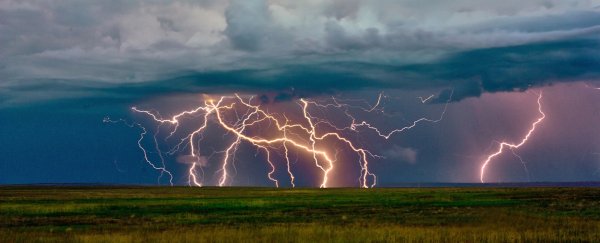High-energy particles released by exploding stars in outer space can be used to probe thunderclouds in order to better understand what triggers lightning, researchers say.
While astronomers usually hope for clear skies, a team in the Netherlands has capitalised on measurements taken during stormy weather to discover a new method for measuring intense electric fields inside thunderclouds.
After re-evaluating 'messy' data relating to the radio emissions from charged particles originating from space - known as cosmic rays - obtained during storms, the researchers say they can accurately determine the strength of the electric fields in thunderclouds.
The researchers say this method could help them gain insight into what triggers lightning, and enable more accurate predictions of lightning activity.
The team responsible for the discovery was using the Low Frequency Array (LOFAR), which is a network of radio antennae and particle detectors spread across five European countries.
It can detect radio waves from distant cosmic phenomena and from sources in Earth's atmosphere.
Cosmic rays originate from exploding stars and other astrophysical sources, and they continuously bombard Earth from space. When these particles hit molecules in the atmosphere, they trigger a reaction in which millions of electrically charged particles shower toward the ground, the researchers say.
These showers can be measured from the radio emission that's generated when their constituent particles are deflected by the magnetic field of Earth.
Between June 2011 and September 2014, researchers at LOFAR measured 762 of the highest-energy showers.
When the weather was clear the radio waves descended in orderly patterns, the researchers said. But when there were thunderclouds overhead, the patterns looked like junk.
"We used to throw away LOFAR measurements taken during thunderstorms. They were too messy," said lead author and astronomer Pim Schellart, from Radboud University Nijmegen in the Netherlands, in a press release.
"Well, we didn't actually throw them away of course, we just didn't analyse them."
But after letting some colleagues look at the anomalous data, the researchers decided they might be worth a closer look.
As Davide Castelvecchi explains for Nature News, "the team redesigned their models to include intense electric fields of the type that usually form inside thunderclouds - in which negative electric charges in a lower layer are separate from positive charges higher up."
By incorporating electric fields in thunderclouds into their models, the team was able to decipher the different measurements.
"This worked very well. How the radio emission changes gives us a lot of information about the electric fields in thunderstorms. We could even determine the strength of the electric field at a certain height in the cloud," said Schellart.
The study, which is published in Physical Review Letters, offers long-awaited proof that a radio-astronomy observatory can be used to probe thunderclouds.
"This paper is groundbreaking since it demonstrates that the idea actually works," Joseph Dwyer, an atmospheric physicist at the University of New Hampshire in the US, who wasn't involved in the research, told Castelvecchi from Nature News.
Lightning is a channel of electric conduction that opens up between layers of clouds, or between clouds and the grouns. It can be both frightening and awe-inspiring, and it strikes on Earth with startling frequency - once every 40 or 50 seconds, or about 1.4 billion times per year. But what causes these intense outbursts is still unclear. Perhaps the key to their enigma lies in cosmic rays.
Source: Nature News
